A History of the County of Berkshire: Volume 4. Originally published by Victoria County History, London, 1924.
This free content was digitised by double rekeying. All rights reserved.
'Parishes: Buscot ', in A History of the County of Berkshire: Volume 4, ed. William Page, P H Ditchfield (London, 1924), British History Online https://prod.british-history.ac.uk/vch/berks/vol4/pp512-517 [accessed 31 January 2025].
'Parishes: Buscot ', in A History of the County of Berkshire: Volume 4. Edited by William Page, P H Ditchfield (London, 1924), British History Online, accessed January 31, 2025, https://prod.british-history.ac.uk/vch/berks/vol4/pp512-517.
"Parishes: Buscot ". A History of the County of Berkshire: Volume 4. Ed. William Page, P H Ditchfield (London, 1924), British History Online. Web. 31 January 2025. https://prod.british-history.ac.uk/vch/berks/vol4/pp512-517.
In this section
BUSCOT
Boroardescote (xi cent.); Burewardescote or Borewardescote, Burewardsci (xii cent.); Burghwardescote (xiii–xv cent.).
The parish of Buscot has an area of 2,887 acres, of which more than half is grass land and only 866 acres are arable, while woods and plantations cover 495 acres. (fn. 1) The soil is alluvium with a subsoil of Oxford Clay. The whole parish lies rather low, the highest point (310 ft.) being reached at Gorse Hill, in the south-east, while at the Thames, on the northern boundary, the level falls to 234 ft.; the western boundary is marked by the River Cole, and here the land is liable to floods.
The village stands at the junction of Snowswick (Sneusweswyke, xiv cent.) (fn. 2) Lane with the road to Lechlade, the church and rectory being situated near the river. The latter is a well-designed two-storied rectangular stone building with barred sash windows, cornice, and hipped roof, apparently of 17th-century date. (fn. 3) At the back are portions of a still older building, which was probably erected at the end of the 15th century.
There is a village reading room, built in 1897 by Sir Alexander Henderson, bart., and a Baptist chapel, built in 1880.
Buscot Park, the residence of Sir Alexander Henderson, bart., lies to the south-east of the village. The house was erected in or about 1780 by Edward Loveden, and is a plain stone building of two stories above a rusticated basement with barred sash windows and balustraded parapet. (fn. 4) It was much improved and enlarged in 1889, when a new wing was added at the west end. It contains several paintings by Sir Edward Burne-Jones. There are two lakes of considerable size in the park, the larger crossed by a bridge of three arches.
Manors
The manor of BUSCOT was held by Earl Harold in the reign of Edward the Confessor and in 1086 by Earl Hugh (fn. 5) of Chester, son of the Conqueror's half-sister. (fn. 6) The overlordship always followed the descent of the earldom of Chester. (fn. 7) The tenant under Earl Hugh in 1086 was called Robert; it has been suggested that this may have been Robert Doyley, (fn. 8) but probably it was Robert son of Hugh, as the lordship afterwards formed part of the honour of Malpas (co. Chester) (fn. 9), held by the descendants of this Robert. William Patrick, one of his co-heirs, is mentioned in con nexion with Buscot as early as 1130, (fn. 10) and it is probable that the whole manor had been included in his share of the honour of Malpas, as the descendants of the other co-heirs are not mentioned in connexion with it. (fn. 11)
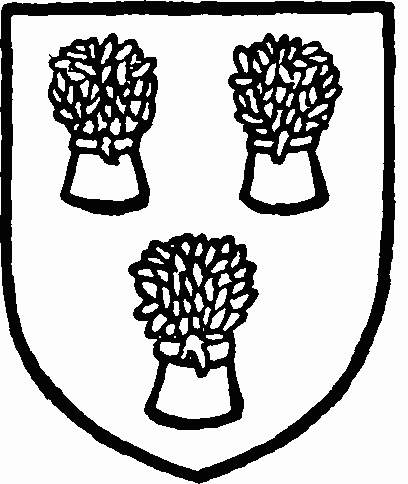
Earldom of Chester. Azure three sheaves or.
In 1086 two under-tenants, Drew and Ranulf, were enfeoffed under Robert; the former held 8 hides and the latter 4. (fn. 12) It was perhaps Ranulf's holding that belonged in 1130 to William Gerbert, who contributed the smaller part of the sum paid in that year by the joint owners of Buscot that the manor might thenceforth be assessed at 6 hides only. (fn. 13) By 1199 his share had passed to Robert Gerbert, (fn. 14) who died before 1243. His widow Galiena and his son William granted 3 carucates of land in Buscot in that year to Roland de Oddingseles and Alice his wife to hold of William and his heirs for the life of Alice, with reversion to Galiena, who had claimed the land as her dower. (fn. 15) In 1277 William Gerbert settled the manor of Buscot except the advowson and the lands then held by John Gerbert and Walrand de Brienne, on his son William Gerbert, together with the reversion after his own death of the advowson and excepted lands. (fn. 16) The manor was held partly of Isabel Patrick and partly of Ralfde Welyngton, whose lordship possibly came to him by descent from Reynold de Whitchurch, second husband of Emma widow of William Patrick. (fn. 17) The younger William Gerbert was described as tenant of the whole at the time of his death in 1283. (fn. 18) He left as his heir an infant son, from whom presumably the property afterwards passed to the Drokensfords.
Michael Drokensford and his brother John, Bishop of Bath and Wells, are said to have held half a fee in Buscot early in the 14th century. (fn. 19) The former must certainly have had lands there in 1316, for he granted 3 carucates in that year to the hospital of St. John Baptist at Lechlade (co. Glouc.) for the foundation of a chantry in his chapel at MICHAEL'S COURT in Buscot. (fn. 20) The Chantry, however, was apparently not kept up after 1370, (fn. 21) and it seems probable that on this account the land reverted to the Drokensfords. (fn. 22) John Drokensford, the son and heir of Michael, died early in 1341, leaving as his heir his son Thomas. (fn. 23) In 1347 Thomas was beyond the seas in the king's service with Sir Walter Mauny, (fn. 24) and it was perhaps while he was abroad that the manor of Michael's Court was held by Nicholas Drokensford and his brother Edward, who were said in 1428 to have been the tenants about 1350. (fn. 25) Sir Thomas Drokensford died in 1362, leaving as his heir his daughter Anne, (fn. 26) afterwards the wife of Sir Thomas Mandeville the younger, who sold the manor in 1375 to Thomas Catewy. (fn. 27)
Thomas Catewy died before 1396, when his heir Walter Catewy was seised of the reversion of Buscot (fn. 28); the manor itself was then held by Joan widow of Thomas Catewy and wife of John Mene, (fn. 29) who granted her interest to Thomas atte Watre, the grandson and heir of Walter Catewy, in 1404. (fn. 30) Three years later Thomas atte Watre settled Michael's Court on himself, his wife Joan and their issue, with reversion, should they die childless, to their trustees Richard Wyot and John Scot and the heirs of Richard. (fn. 31) In 1428 the manor was in the possession of John Gardiner, perhaps a tenant for life, (fn. 32) but it passed before 1474 to Thomas Stonor, (fn. 33) and subsequently followed the descent of Didcot (q.v.) until 1557, (fn. 34) when Francis Stonor conveyed it to Walter Loveden and Dorothy his wife. (fn. 35) Walter died in 1580, his son and heir Walter in the following year, (fn. 36) and the manor passed to a younger son John, (fn. 37) who held it till at least 1623, (fn. 38) and was followed by a son Walter, who dealt with it in 1649. (fn. 39) Edward Loveden, perhaps a cousin of Walter, (fn. 40) was in possession in 1653. (fn. 41) His son Roger, who succeeded in 1659, only survived him for two years, leaving a son Edward, then aged six. (fn. 42) Edward died in 1713 leaving two sons John and Edward who held the manor in turn. (fn. 43) The latter, dying unmarried in 1749, bequeathed his estates to his great-nephew Edward Loveden Townsend, directing that he should take the name Loveden. (fn. 44) This Edward died in 1822. (fn. 45) His son Pryse Loveden, who had taken the name of Pryse Pryse in 1798, on inheriting his mother's estates, died in 1849. Pryse son of Pryse assumed the name of Loveden and died in 1855. The manor was sold by his son Pryse (Sir Pryse Pryse, bart.), to Robert Campbell, who died in 1887. In 1889 Sir Alexander Henderson, the present owner, purchased the manor from Robert Campbell's trustees. (fn. 46)
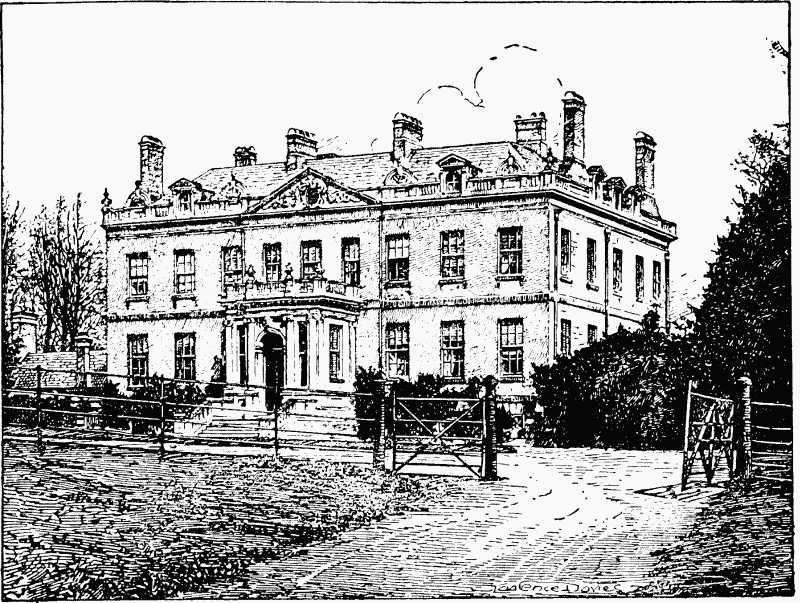
Buscot Park
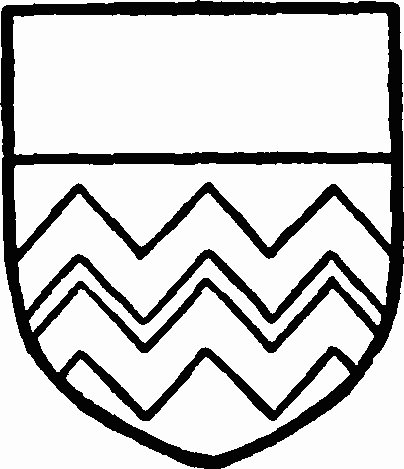
Stonor. Axure two bars dancetty or with a chief argent.
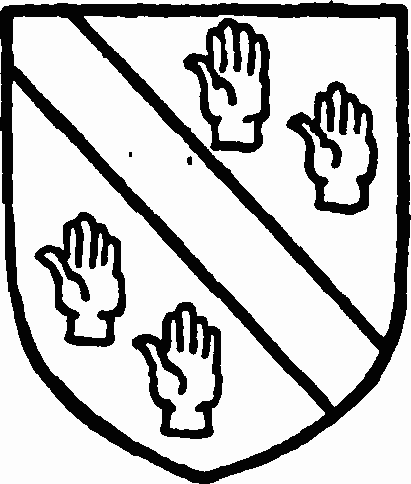
Loveden. Gules a bend between four left hands argent cut off at the wrist.
The estate which belonged in the early 14th century to John Drokensford, Bishop of Bath and Wells, appears to have been the part of Buscot which was under the mesne lordship of the Welyngton family and their successors the lords of Stalpits (fn. 47) (q.v.). Philip Drokensford, brother and heir of John, (fn. 48) succeeded him in 1329, (fn. 49) but was in possession of his land in Buscot two years earlier. (fn. 50) This holding seems to have been called after him the manor of Philip's Court, corrupted to PHILPOT'S COURT. Philip had a son Philip, who was his heir-apparent in 1337. (fn. 51) and was probably the Philip Drokensford who died seised of the manor of Buscot in 1355, (fn. 52) leaving a son and heir John. (fn. 53) John was dead by 1370, (fn. 54) when his lands had passed to Margaret wife of Walter Mildecombe, (fn. 55) perhaps his daughter. (fn. 56) Margaret and Walter conveyed the manor in 1372 to Adam Louches, (fn. 57) who made a conveyance of the advowson eight years later. (fn. 58) In 1381 George Louches conveyed Philpot's Court to John de Estbury and others. (fn. 59) From them it passed to Thomas Childrey, who died in possession in 1407, (fn. 60) his wife Elizabeth having a life interest. (fn. 61) It then followed the descent of Upton Russels (q.v.) in the Beckingham family. (fn. 62) Mary (Beckingham) (fn. 63) widow of Thomas Windsor died seised of it in 1574, (fn. 64) and her son and heir Andrew obtained a grant of the right to hold courts in Buscot in 1614. (fn. 65) Andrew Windsor was succeeded in 1622 by his brother Peter, (fn. 66) whose son and heir Thomas died in 1631, leaving a son Andrew, (fn. 67) who only survived him by a few months. (fn. 68) Robert, the infant son of the latter, died in 1633, (fn. 69) and the estate then devolved upon his uncle Richard, younger brother of Andrew. (fn. 70) Richard Windsor sold the manor in 1639 to Sir Edward Yate, bart., of Buckland, (fn. 71) whose granddaughter Mary married Sir Robert Throckmorton, the holder in 1744. (fn. 72) and 1762. (fn. 73) The latter sold it in 1788 to Edward Loveden Loveden, (fn. 74) then owner of Michael's Court, with which it was thus amalgamated.
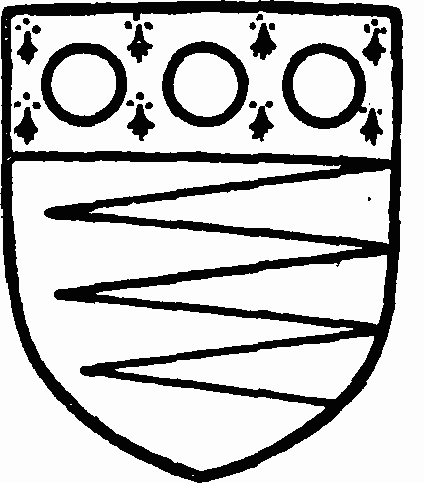
Henderson, baronet. Or three piles vert issuing from the sinister and a chief ermine with three roundels gules therein.
The land held in demesne by Robert son of Hugh in 1086. (fn. 75) passed with part of the barony of Malpas to his descendants the family of Patrick. (fn. 76) Robert Patrick granted to Emma widow of William Patrick all her late husband's demesne in Buscot as dower in 1199, (fn. 77) and the manor of Buscot and all services were confirmed to her by Robert's son William in 1225 after her marriage to Reynold de Whitchurch. (fn. 78) After her death it reverted to the Patricks, and in 1293 Isabel the widow of Robert Patrick held a messuage and 2 carucates of land in Buscot of the gift of Isabel daughter and heir of William Patrick. (fn. 79) The younger Isabel, after the death of her first husband Philip Burnel in 1282, married Richard de Sutton, (fn. 80) who held the manor by courtesy in 1316. (fn. 81) John the son and heir of Isabel and Richard succeeded before 1322; he demised the manor for life to Richard Paynel, upon whom, together with his wife Sibyl, 7 virgates of land in Buscot had already been settled. (fn. 82) Subsequently a grant in fee was made to the Paynels, and in 1338 Richard obtained a grant of free warren in Buscot for himself and his heirs. (fn. 83) The manor, which became known as PAYNEL'S COURT, was held in succession by John (fn. 84) and Thomas Paynel, (fn. 85) the latter of whom sold it in 1381 to Thomas Catewy. (fn. 86) It followed the descent of Michael's Court (q.v.) until 1407, (fn. 87) but was afterwards separated for a time, the tenant in 1428 being Simon Reilegh. (fn. 88) Before 1474 both manors had come into the hands of Thomas Stonor, (fn. 89) and since that date they have followed the same descent.
One-sixth of this manor was held in socage of Simon Reilegh in 1428 by William Perkyns, (fn. 90) who had succeeded to the lands of the Paynels in Ufton Robert (q.v.). His descendants continued to hold lands in Buscot. (fn. 91) In 1627 this property, described as a manor belonging to Francis Perkyns, recusant, was leased for twenty-one years to William Eyston. (fn. 92) It was sold by James Perkyns, who died in 1755, (fn. 93) after which date the descent is lost.
Four hides of land in Buscot, probably representing part of the land held by Drew in 1086 and by Robert Grevesac in 1130, (fn. 94) were held in the 13th century by the Martel family, whose holding extended into Coleshill and Watchfield. Gilbert Martel, who was living at least as late as 1208, (fn. 95) bequeathed his body, together with a virgate of land in Buscot which he had bought from Robert Trame to the hospital of St. John of Jerusalem. (fn. 96) His charter was witnessed by Sir Geoffrey Martel, probably the Geoffrey who granted half a hide in Watchfield to William Martel in 1206 (fn. 97) and 1 hide in Buscot to Geoffrey the son of Samson in 1218; he retained in the latter year 3 hides in Buscot held of Geoffrey son of Samson. (fn. 98) By 1252 his lands had passed to his nieces Wentlian (? Gwenllian) and Emma, daughters and co-heirs of William Martel, and in that year Wentlian quitclaimed her share in Coleshill and Watchfield to her sister, then the wife of William Lumbard. (fn. 99) It seems probable that the land in Buscot followed the same descent, for in 1254 William Lumbard and Emma his wife granted 3 virgates there to William Gerbert, (fn. 100) who gave them before 1264 to the hospital of St. John Baptist at Lechlade. (fn. 101) The prior's holding, which was valued at £3 2s. 6d. in 1291, (fn. 102) seems to have been let to various tenants. About 1450 Prior John Wyham demised a tenement called Prior's Court in 'Beruscot' to John Patyn, Joan his wife and Richard their son for their lives, (fn. 103) but its descent after this date is obscure. (fn. 104)
Tenements in Buscot were held of the Patrick family by Peter Achard before 1225. (fn. 105) In 1331 Robert Achard settled two messuages and a carucate on Richard de Coleshill. (fn. 106) This land was probably absorbed into the manor of Coleshill, with which it was granted to Edington Priory in 1366. (fn. 107)
A fishery is mentioned in the Domesday Survey, to which there are some later references. (fn. 108)
Church
The church of ST. MARY consists of a chancel 29 ft. 6 in. by 14 ft. 3 in., nave 46 ft. 10 in. by 20 ft. 6 in., south porch and west tower 10 ft. square, all these measurements being internal. There is also a modern vestry at the east end of the north wall of the nave.
The walling throughout is of rubble with ashlar dressings, but the chancel, porch and the south side of the nave are rough-casted; the roofs are eaved and covered with stone slates. With the exception of the tower and porch the plan would appear to represent substantially a building of c. 1200, the east wall of the nave, including the chancel arch, being of that date, and perhaps part of the chancel. The outer order of the chancel arch is, however, part of a 12thcentury arch with double zigzag ornament re-used, (fn. 109) and indicates that a building of that date preceded the present one. The chancel windows and other details belong to the first quarter of the 13th century, but the presence of two piscinae and aumbries of different types argues a lengthening or alteration of the chancel in the latter half of the century. The porch and tower were added in the 15th century, at which time the nave may have been refashioned, the south doorway and the only ancient window now remaining being of that period. The two windows on the south of the nave date from 1854, when the church was restored, but do not reproduce ancient work. In 1849 there was one lancet in the nave, the other windows being 'perpendicular.' (fn. 110)
The chancel has an east window of a single light, which appears to have been a wide lancet mutilated in the 18th century, when plaster ceilings were erected. It has now a rounded arch flat at the top, but the pointed chamfered rear arch remains. The window is now filled with stained glass by BurneJones representing the Good Shepherd. Near the east end of the north wall is an original narrow lancet, and at the west end of the south wall is a similar one. Opposite to these on either side are wider pointed windows with foliated rear arches, which may originally have been of two lights. The priest's doorway, now built up, is square-headed and is a later insertion or restoration. On the south side is a trefoiled piscina with foliated bowl, and in the east jamb of the window an aumbry of similar type rebated for a door. The sill of the window forms a sedile. A second piscina (fn. 111) has a shouldered head and foliated bowl. The second aumbry, which is also shouldered, is in the middle of the east wall behind the altar. The chancel arch is pointed and of three orders towards the nave and two to the chancel. On the nave side the middle and outer orders spring from angle shafts with carved capitals and moulded bases. The detail of the carved capitals is of the 13th century with stiff-leaf foliage. A small nail-head ornament occurs in two of the capitals and the inturned volute in another, and the imposts have a hollow moulding. The north jamb leans considerably outwards. The chancel has a barrel-vaulted plaster ceiling with a single tie-beam, and all the walls are plastered internally.
The nave is of little architectural interest. The old window on the north side is a square-headed opening of two rounded lights high up in the wall, with external hood mould terminating in heads. At the north-east and south-east angles are flat double buttresses of c. 1200, but the four buttresses on the north side are probably of 15th-century date. The south doorway has a four-centred moulded arch with square hood mould and plain spandrels, but the semicircular outer doorway of the porch is modern or a restoration. The gable coping and finial are old. The line of the old nave roof on the east side of the tower shows the ridge to have been slightly higher and the roof of flatter pitch than at present, the walls having been apparently reduced in height when the existing roof was erected. It has a curved plaster ceiling.
The tower is externally of two stages, the lower being about two-thirds of the total height, and has diagonal buttresses, moulded plinth and embattled parapet. The belfry windows are square-headed and of two trefoiled lights, and the pointed west window is of three cinquefoiled lights with perpendicular tracery. The four-centred west doorway has a square label terminating in heads, and there is a mural sundial near the south-east angle. The north and south sides of the lower stage are blank, except for a small opening to the ringing stage. The tower arch is of two orders, the outer moulded and dying into the wall, and the inner chamfered, springing from shafts with moulded capitals and bases.
The font consists of a plain circular bowl moulded on the lower and upper edges, standing on a modern shaft and square 13th-century base moulded at the angles.
The pulpit was given by Sir Alexander Henderson, bart., in 1908, and is constructed from a carved Flemish triptych of early 16th-century date, with painted panels said to be by Mabuse, representing the Adoration of the Kings, (fn. 112) the Annunciation and the Virgin and Child, the two latter being on the shutters.
On the south wall of the chancel are two late 15th-century brasses of a man and woman with hands in prayer, each 2 ft. in length. There is no inscription, and the head of the man is missing. The chancel also contains two elaborate mural monuments to the two wives of Edward Loveden Loveden of Buscot Park, Elizabeth Pryse (d. 1784) and Elizabeth Darker (d. 1788). In the floor is a blue armorial slab to Walter Hungerford, D.D. (d. 1681). The nave contains memorials to Mrs. Susanna Place, eldest daughter of Roger Loveden (d. 1686), and to Edward Loveden (d. 1713).
There is a ring of three bells. The second is of pre-Reformation date, and bears the inscription ' † Sandta (sic) Maria W.', the treble was cast by Edward Neale of Burford in 1661, and the tenor by William & Robert Cor of Aldbourne in 1708. (fn. 113)
The plate is all silver gilt, and consists of a cup of 1711–12, inscribed 'Burwescott Parish in Berkshire. Geo. Browne, John Nash, Churchwardens, 1712. Gilt at the Expence of Edward and Margaret Loveden 1779'; a breadholder of 1710–11, inscribed 'Ex dono Thomae Kingston hujus ecclesiae Rectorisanno domini 1711. Gilt at the expence of Edward and Margaret Loveden 1779,' with the maker's mark RY below a crown; and a cover paten and flagon of 1779, both inscribed 'The Gift of Edward and Margaret Loveden for the Use of the Parish Church of Buscott 1779.'
The registers before 1812 are as follows: (i) all entries from 1676 to October 1744; (ii) from July 1745 to December 1798; (iii) from January 1799 to November 1812.
The churchyard is entered at the south-east through a lych-gate erected in 1897 by Sir Alexander Henderson.
Advowson
In 1291 the church of Buscot was valued at £15. (fn. 114) The advowson was attached to the Gerberts' manor in the 13th century. (fn. 115) From the 14th to the 18th century the lords of Michael's Court, Philpot's Court and Paynel's Court all claimed a share in the advowson. (fn. 116) The shares were united by Edward Loveden in 1788. Sir Alexander Henderson is the present patron. The living is a rectory.
There was a chapel attached to the manor of Michael's Court in 1316, when Michael Drokensford founded the chantry there already mentioned, for the upkeep of which he granted 3 hides of land in Buscot to the Prior of St. John's Hospital, Lechlade. (fn. 117) The chantry was, however, said to have been disused for twenty years as early as 1392. (fn. 118)
Charities
In 1749 Edward Loveden by his will gave an annuity of £2 4s. out of his property at Weston, to be laid out in buying four coats yearly for four poor men. The annuity is received from the Buscot estate.
In 1801 Mrs. Elizabeth Nash, by her will proved in the P.C.C. 15 December, bequeathed a sum to purchase stock the interest of which would buy annually twenty coats for twenty poor men and the same number of gowns and petticoats for twenty poor women. The trust fund consists of £1,166 13s. 4d. consols, now producing £29 3s. 4d. yearly, which is duly applied.
In 1833 Jane Gill by a codicil to her will bequeathed £100, the dividends to be applied in coals for heating the parish church. The legacy, less duty, is represented by £102 15s. 3d. consols, the annual dividends of which, amounting to £2 11s. 4d., are applied as directed.
In 1861 the Rev. Samuel Heckford, by his will, bequeathed (after the death of his widow, which event happened in 1867) £100 consols, the dividends, subject to the repair of his daughter's tomb in the churchyard, to be applied for the benefit of poor widows and widowers. The trust fund consists of £99 12s. 8d. consols, producing £2 9s. 8d. yearly which is distributed in coal.
In 1863 the Rev. Christopher Cleobury, by his will proved at Salisbury 31 December, bequeathed £50, the income to be applied in bread, fuel or clothing. The trust fund consists of £56 9s. 11d. consols. The annual dividends, amounting to £1 8s., are duly applied.
The several sums of stock are held by the official trustees.
